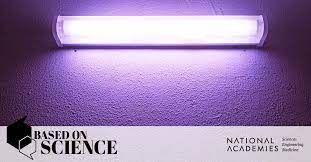A long-neglected technology offers new hope to Canadians that invisible viruses can be eradicated. The solution is ultraviolet light, invisible to the human eyes, but deadly to pathogens. And its proper application seems to be more effective than disinfectant chemicals.
This new tech solution has its roots in a discovery way back by A. Downes and T.P. Bluntin a paper published back in 1877 in Nature that explained that sunlight prevents microbial growth. An old wives’ saying was “Sunlight is the best disinfectant.”
This concept was further developed in the 1930s when F.L. Gates showed that UltraViolet Germicidal Irradiation (UVGI) could prevent bacterial spread, working best at a wavelength of 265 nanometres, somewhat below the 400 to 700 nm range of visible light.
Gates investigated the important idea of airborne infection by evaporated droplets of water and then showing that UVGI would kill those germs. Soon after this discovery, UV lights were put into Philadelphia schools to counteract a measles epidemic.
In the 1950s, R.L. Riley and colleagues showed that UVGI was effective against aerosolized tuberculosis germs. In 2009, Dr. Rod Escombe confirmed this finding in a controlled clinical evaluation. At the time, an appropriate UV ceiling light cost US$350, while replacing ordinary light bulbs was just $25.
In 2019, a study published in The American Journal of Infection Control showed that ultraviolet light, used in 90-second cycles, was 92 to 97.7 percent effective in killing pathogens in New York metropolitan hospitals, compared to just 52.8 to 90.9 percent by typical chemical disinfections. A combined approach killed 96.3 to 99.6 percent of germs effectively.
UVGI works by breaking down the DNA bonds in micro-organisms, preventing them from replicating. According to the Phillips company, which sells UV lamps, there are no known pathogens resistant to UV-C.” In fact, Italian researchers have shown that UV light is highly effective against SARS-CoV-2, the virus that causes COVID-19.
Research in recent decades placed the optimal disinfection wavelength at 254 nm, which, unfortunately, poses a cancer risk for humans after extended exposure. One solution is to apply the light within air ducts or shine it near the ceiling in a room with well-circulated air. This allows disinfection without direct human exposure.
A more promising approach is to use slightly shorter wavelength 222 nm rays. In 2020, Japanese researchers showed that this wavelength is near-optimal at sterilizing germs but won’t cause cancer in animals. Karl Linden at the University of Colorado Boulder has shown this wavelength is also effective against SARS-CoV-2.
Finally, 90 years after its discovery, UV lights are in the early stages of becoming publicly accepted. LED UVs have been used for water disinfection for a decade. Robots, such as Tru-D and Zenex, roam hospitals shining their disinfecting lights to disinfect public spaces. UVGI is used in South Korean bus shelters, New York City subways and buses, the Space Needle in Seattle, and some restaurants. Airplanes are next, with Boeing showing particular interest in this new technology.
UVGI deserves more research and implementation, as the past 30 months illustrated. If a real pandemic can be managed without lock downs and coerced vaccinations, all the better.
Let freedom live and the viruses die.
Lee Harding is a Research Associate for the Frontier Centre for Public Policy.



